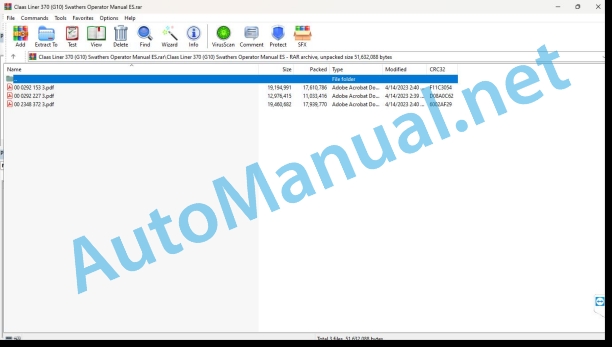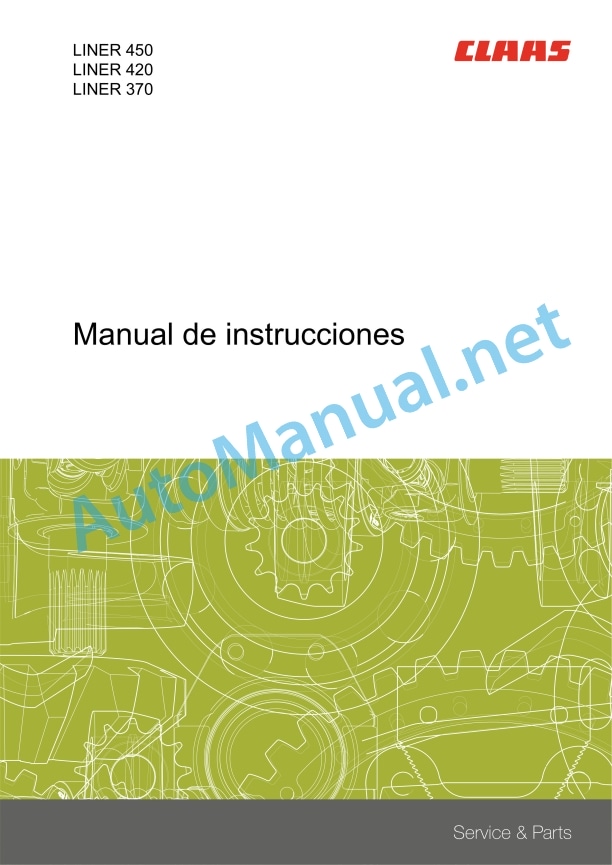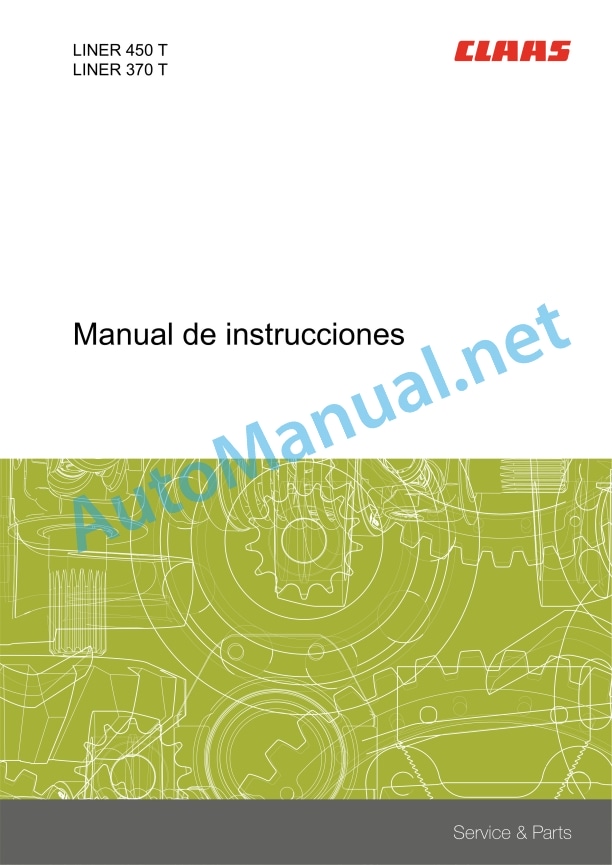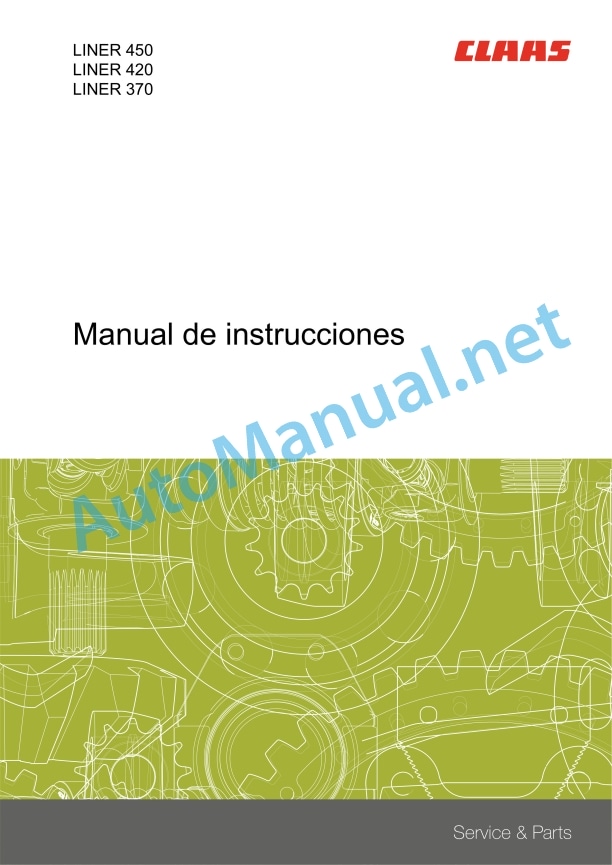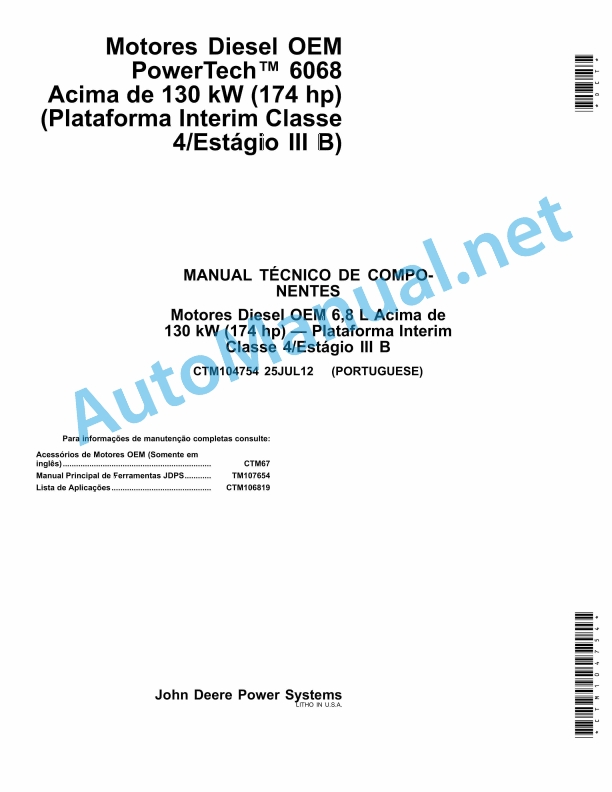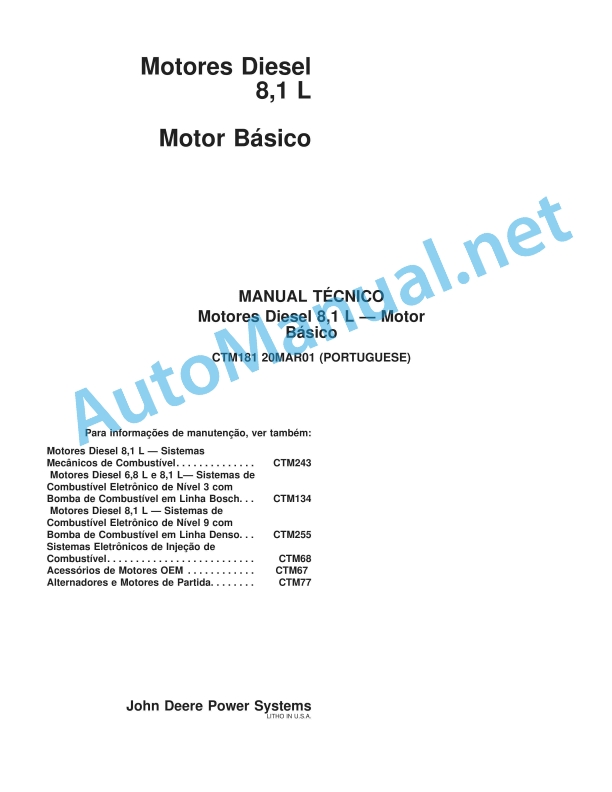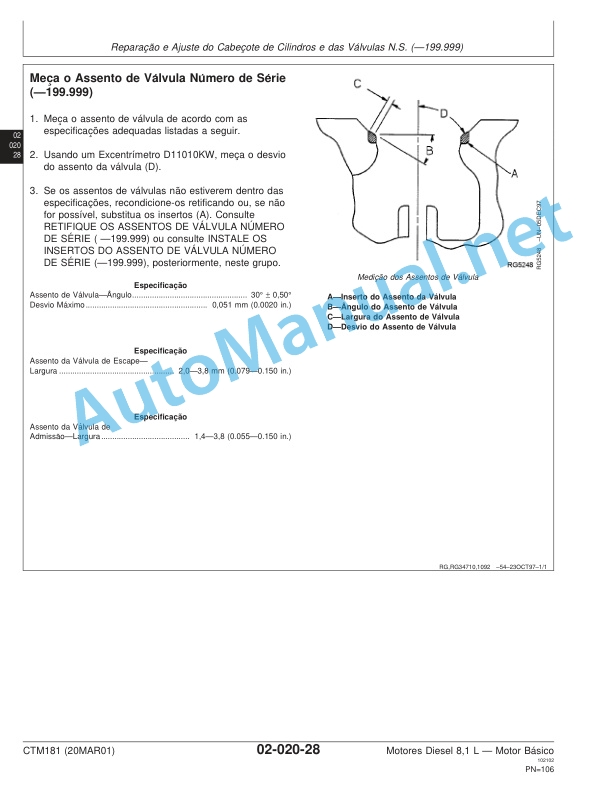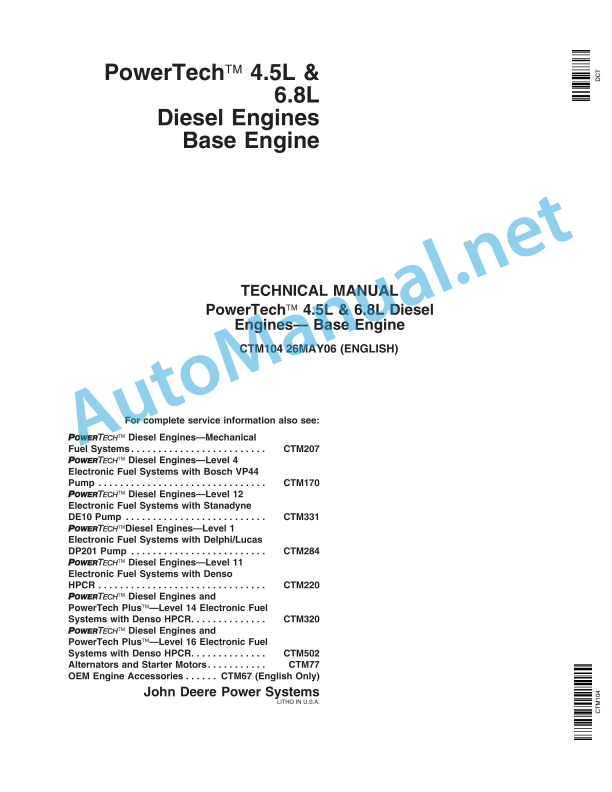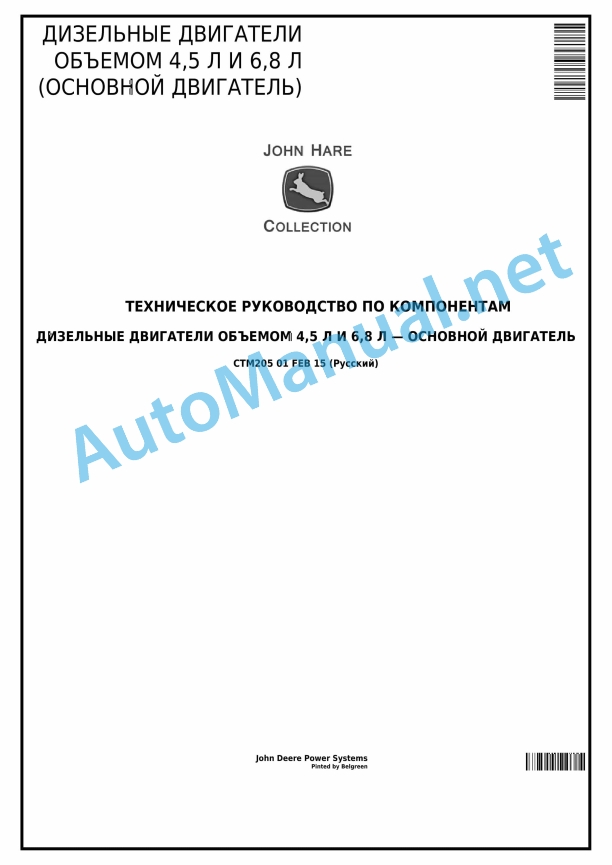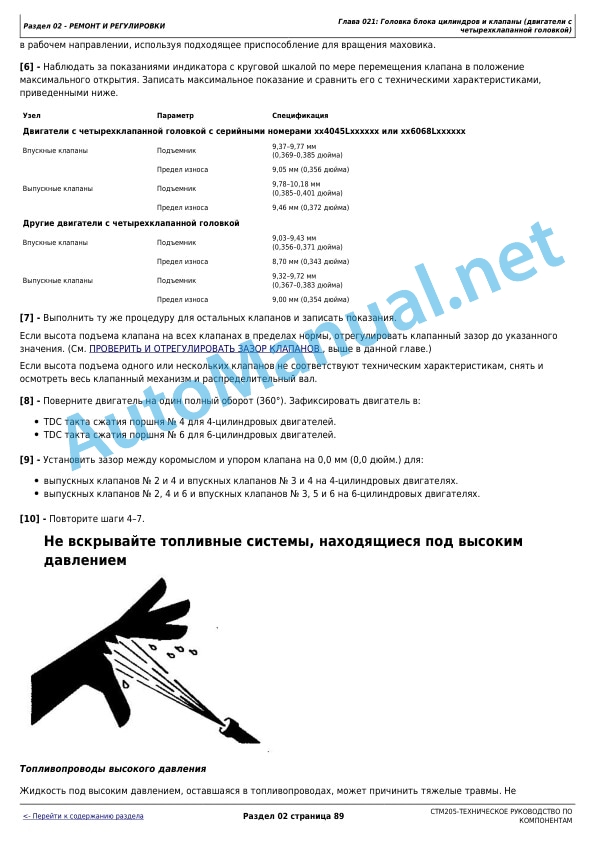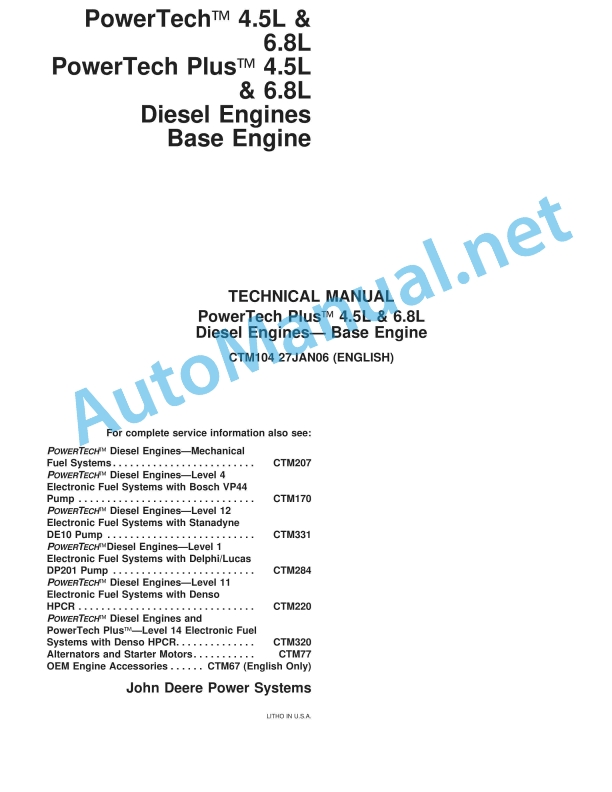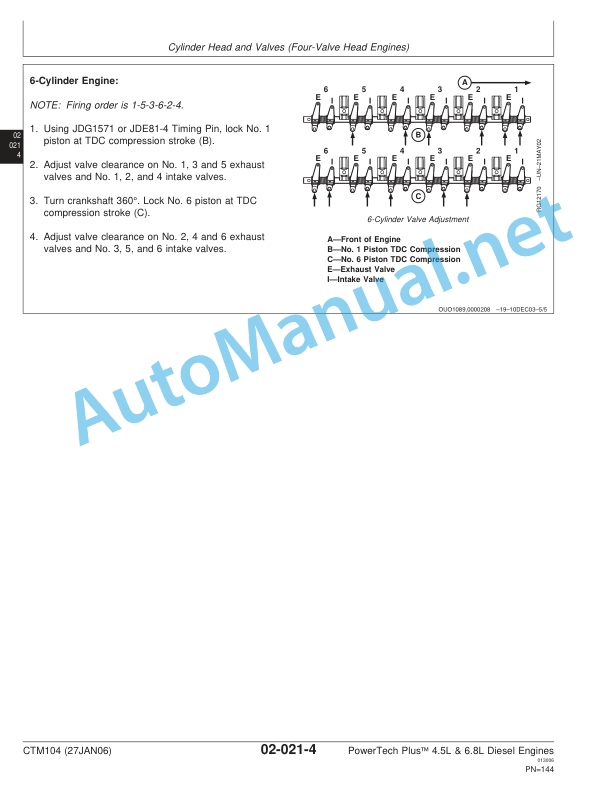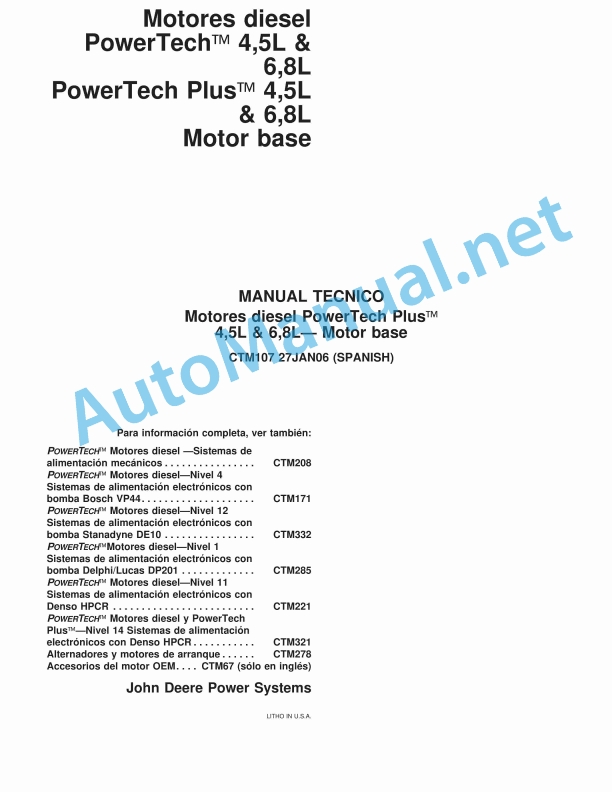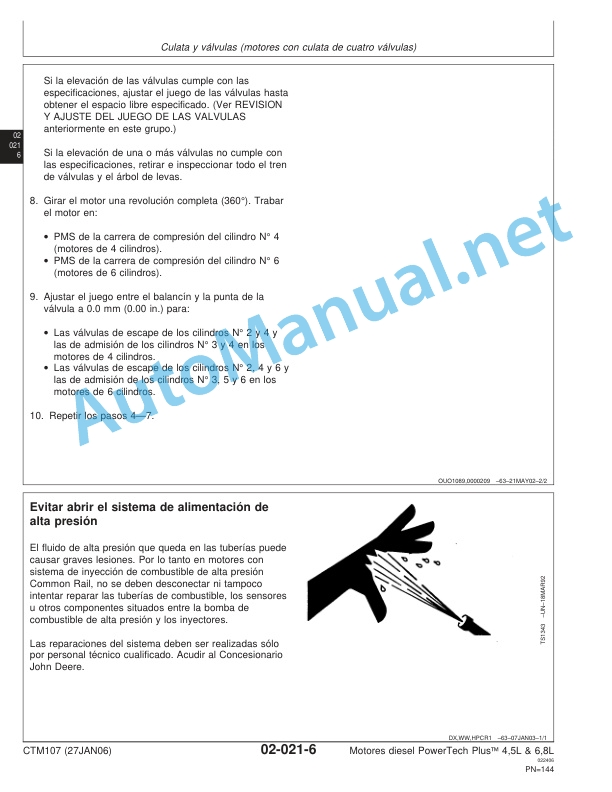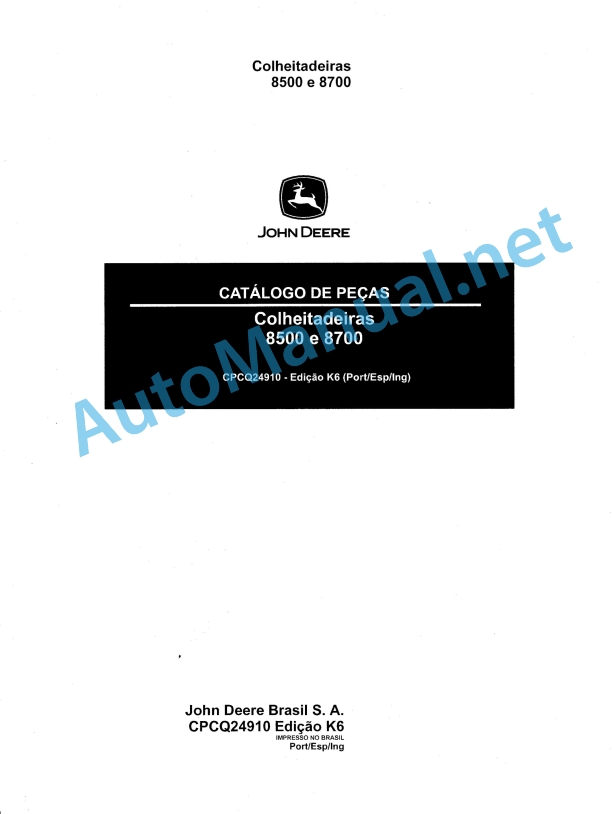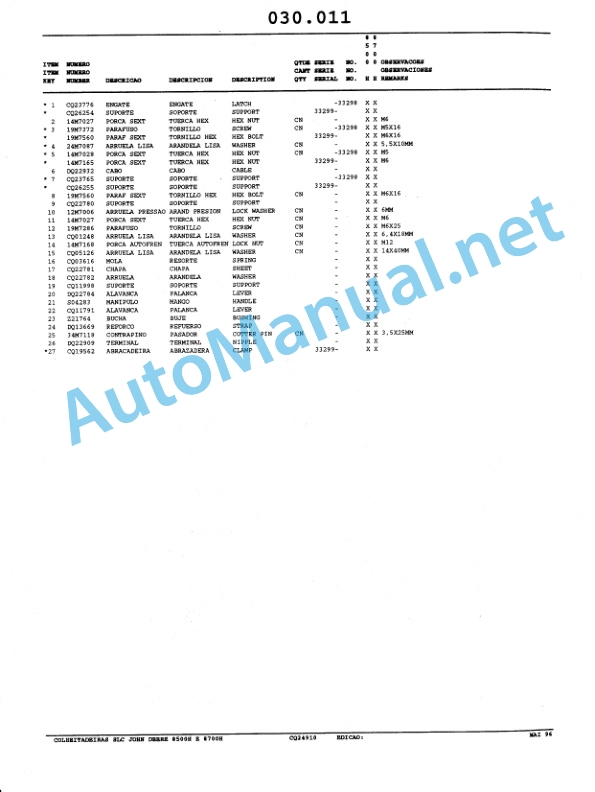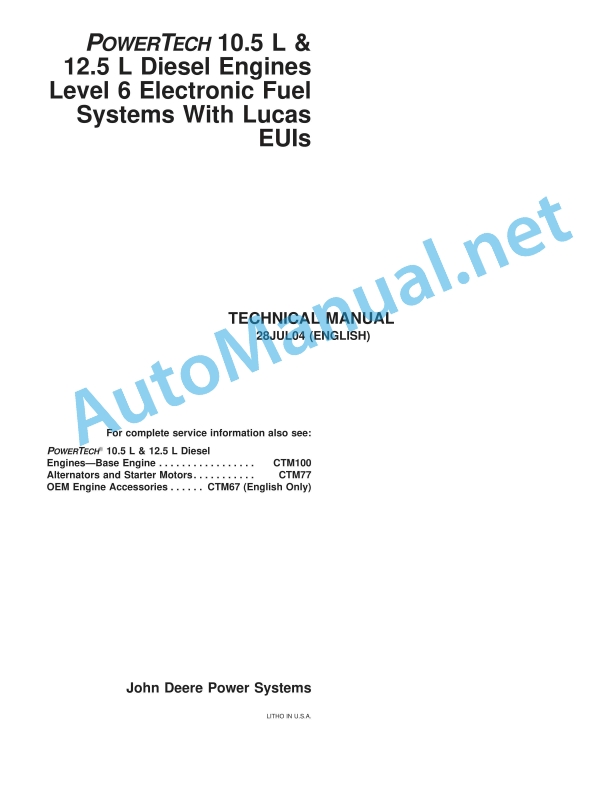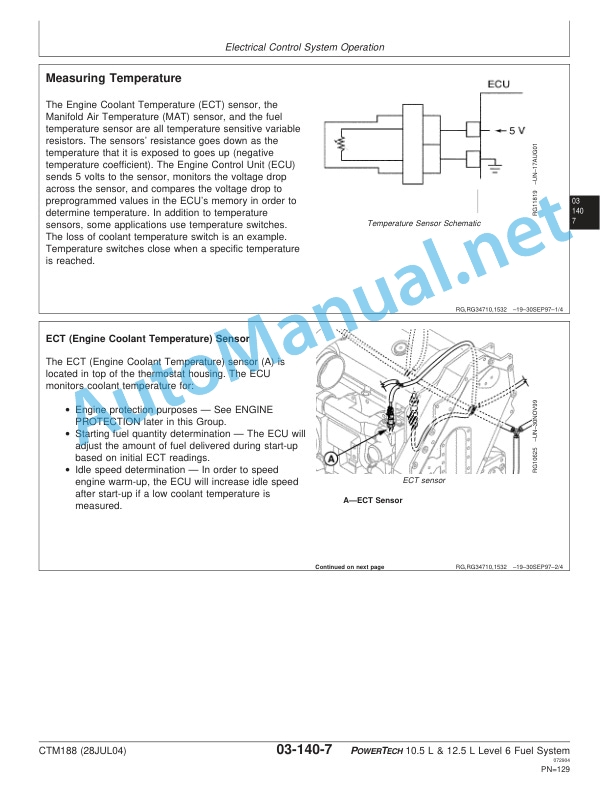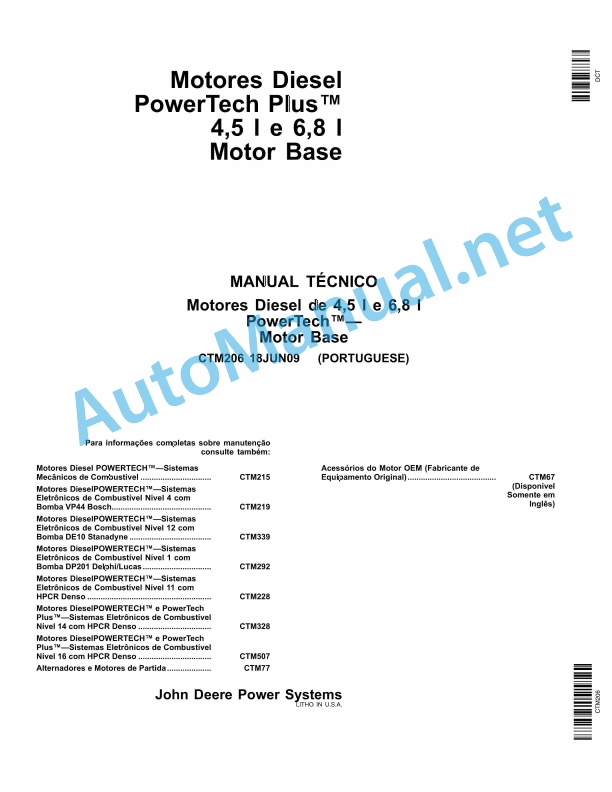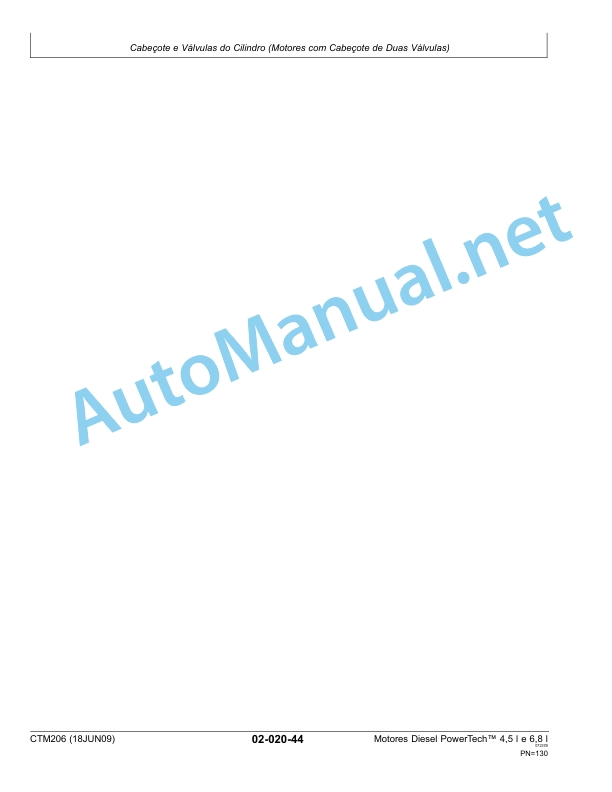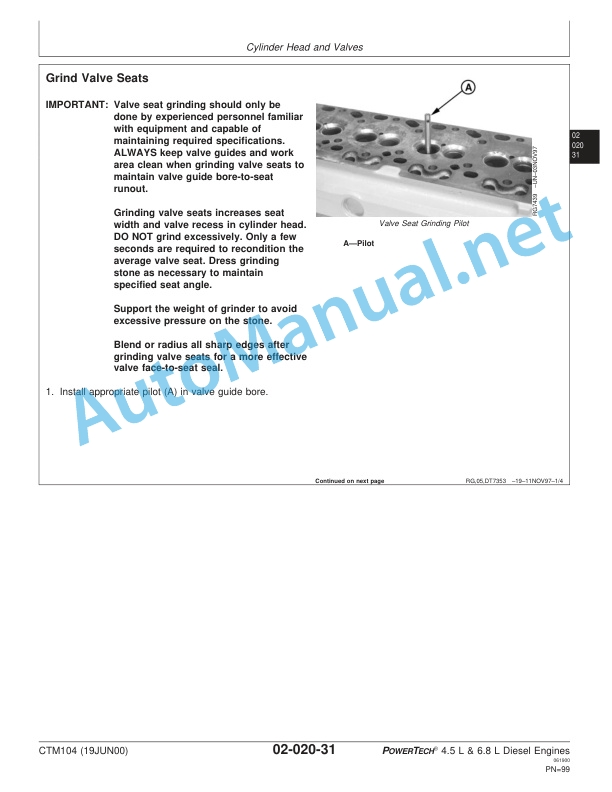Claas Liner 370 (G10) Swathers Operator Manual ES
$50.00
- Model: Liner 370 (G10) Swathers
- Type Of Manual: Operator Manual
- Language: ES
- Format: PDF(s)
- Size: 44.4 MB
File List:
00 0292 153 3.pdf
00 0292 227 3.pdf
00 2348 372 3.pdf
00 0292 153 3.pdf:
LINER 450LINER 420LINER 370
1. Introduction
1.1 Information regarding the instruction manual
1.1.1 Validity of the manual
1.1.2 Information relating to this instruction manual
1.1.3 Symbols and indications
1.1.4 Optional equipment
1.1.5 Qualified specialized workshop
1.1.6 Maintenance instructions
1.1.7 Information regarding warranty
1.1.8 Spare parts and technical issues
1.2 Proper application of the machine
1.2.1 Proper machine application
1.2.2 Logically foreseeable inappropriate application
2 Security
2.1 Recognize warning signs
2.1.1 Danger symbols
2.1.2 Keyword
2.2 Safety instructions
2.2.1 Meaning of the instruction manual
2.2.2 Observe graphic danger symbols and alarm indications
2.2.3 Requirements for all people working with the machine
2.2.4 Children in danger
2.2.5 Danger zones
2.2.6 Position yourself between the tractor and the machine
2.2.7 Accompanying persons
2.2.8 Couple the tractor with the machine
2.2.9 Risk of injury due to rotating shafts
2.2.10 Construction changes
2.2.11 Optional equipment and spare parts
2.2.12 Control of the machine in operation
2.2.13 Operation only after correct commissioning
2.2.14 Technical status
2.2.15 Danger due to machine breakdowns
2.2.16 Comply with technical limit values
2.2.17 Danger due to coasting parts
2.2.18 Keep protective devices operational
2.2.19 Personal protective equipment
2.2.20 Wear appropriate clothing
2.2.21 Remove dirt and loose objects
2.2.22 Prepare the machine for road traffic
2.2.23 Dangers when driving on the road and in the countryside
2.2.24 Park the machine safely
2.2.25 Parking without supervision
2.2.26 Unsuitable consumables
2.2.27 Safe handling of consumables and auxiliary materials
2.2.28 Fire protection
2.2.29 Environmental protection and waste disposal
2.2.30 Deadly electrical discharge through overhead lines
2.2.31 Behavior in the case of an overhead line voltage transfer and lightning strike
2.2.32 Liquids under pressure
2.2.33 Hot surfaces
2.2.34 Work only on the stopped machine
2.2.35 Maintenance work and repair work
2.2.36 Machine parts and lifted loads
2.2.37 Danger from welding work
2.3 Safety signage
2.3.1 Structure of graphic hazard symbols
2.3.2 Position of warning symbols on the machine
3 Machine Description
3.1 Summary and operation
3.1.1 Summary
3.1.2 Operating mode
3.2 Optional machine equipment
3.2.1 Feeler wheel on the three-point support*
3.2.2 Hydraulically foldable protections*
3.2.3 Hydraulic adjustment of rotor height*
3.2.4 Fourth prong*
3.2.5 Warning signs*
3.2.6 Illuminated warning signs*
3.2.7 Warning signs Italy*
3.2.8 Legal equipment France*
3.2.9 SMV Triangle*
3.2.10 Lighting adapter for USA*
3.3 Identification plates and identification numbers
3.3.1 Machine identification plate
3.4 Machine information
3.4.1 Adhesive on the machine
4 Control and display instruments
4.1 Control elements
4.1.1 Windrower rotor
4.1.2 Protection
5 Technical data
5.1 LINER450
5.1.1 Measurements
5.1.2 Weights
5.1.3 Tractor requirements
5.1.4 Version
5.1.5 Tire pressure
5.1.6 Acoustic intensity level
5.1.7 Lubricants
5.2 LINER420
5.2.1 Measurements
5.2.2 Weights
5.2.3 Tractor requirements
5.2.4 Version
5.2.5 Tire pressure
5.2.6 Acoustic intensity level
5.2.7 Lubricants
5.3 LINER370
5.3.1 Measurements
5.3.2 Weights
5.3.3 Tractor requirements
5.3.4 Version
5.3.5 Tire pressure
5.3.6 Acoustic intensity level
5.3.7 Lubricants
6 Preparation of the machine
6.1 Adapt the tractor
6.1.1 Check the tractor ballast
Calculate the minimum front ballast
Calculate the minimum rear ballast
Calculate the actual load on the front axle
Calculate the actual total weight
Calculate the actual load on the rear axle
Calculation table
6.1.2 Calculate the minimum front counterbalance
6.1.3 Calculate the minimum rear counterweight
6.1.4 Calculate the actual front axle load
6.1.5 Calculate the actual total weight
6.1.6 Calculate the real rear axle load.
6.1.7 Calculation table
6.1.8 Check the tractor power take-off protection device
6.2 Turn off the machine and secure it
6.2.1 Shut down and secure the machine and tractor
6.2.2 Secure the lifted machine
6.3 Adapt the machine
6.3.1 Cardan shaft – check the length
6.3.2 Cardan shaft – adapt the length
6.3.3 Assemble the cardan shaft to the machine
6.3.4 Adjust the inclination of the rotor chassis
6.4 Hooking up the machine
6.4.1 Attach the support to three points
6.4.2 Assemble the cardan shaft
6.4.3 Place the support leg upwards
6.4.4 Attach the hydraulic hoses of the hydraulically foldable protection stirrups*
6.4.5 Connect the hydraulic hoses for the hydraulic rotor height adjustment*
6.4.6 Plug in the lighting cable
6.4.7 Save the shim
6.5 Unhooking the machine
6.5.1 Secure the machine so that it cannot roll
6.5.2 Place the support leg down
6.5.3 Remove the lighting cable
6.5.4 Uncouple the hydraulic hoses from the hydraulically foldable protection stirrups*
6.5.5 Disconnect the hydraulic hoses from the hydraulic rotor height adjustment*
6.5.6 Dismantle the cardan shaft
6.5.7 Unhook the three-point support
6.6 Prepare for road traffic
6.6.1 General security measures
6.6.2 Push the swath cloth inwards
6.6.3 Rotate the protection bar upwards
6.6.4 Turning the folding hydraulic protections upwards*
6.6.5 Close the stopcock of the hydraulically foldable protective stirrups*
6.6.6 Remove the tine holder
6.6.7 Remove the tine holder
6.7 Prepare for use at work
6.7.1 Assemble the tine holders
6.7.2 Assemble the tine holders
6.7.3 Turn the protection downwards
6.7.4 Open the stopcock of the hydraulically foldable protective stirrups*
6.7.5 Swing down the hydraulically foldable guardrails*
6.8 Load the machine
6.8.1 Lift the machine
7 Management
7.1 Driving on the road
7.1.1 Driving on public roads
7.2 Settings for use at work
7.2.1 Adjust the swath rotor
7.2.2 Adjust the feeler wheel* on the three-point support
7.2.3 Adjusting the row former
Adjust swath width
7.2.4 Adjust the working height
Adjust the working height with the crank
Adjust the working height with hydraulic rotor height adjustment*
7.2.5 Control the working height
7.3 Use at work
7.3.1 Make rows
7.3.2 Adapt the power take-off speed
8 Incident and solution
8.1 Chassis
8.1.1 Change the swath rotor chassis wheel
8.2 Electrical and electronic system
8.2.1 Defective bulbs*
9 Maintenance
9.1 Summary of maintenance intervals
9.1.1 Before harvest
9.1.2 After the first 10 hours of service
9.1.3 After the first 50 hours of service
9.1.4 Every 20 hours of service
9.1.5 Every 50 hours of service
9.1.6 Every 500 hours of service or annually
9.1.7 if necessary
9.1.8 After harvest
9.2 Gearbox
9.2.1 Check the tightness of the gear
9.2.2 Windrower gear: Check the oil level
9.2.3 Windrower gear: Change oil
9.2.4 Windrower gear: Check the oil level
9.2.5 Windrower gear: Change oil
9.2.6 Windrower gear: Retighten the screws
In the chassis-swather gear bolted connection
On the swath gear
9.3 Cardan shaft
9.3.1 Maintenance of cardan shafts
9.3.2 Check the overload clutch
9.4 Chassis
9.4.1 Check tire pressure
9.4.2 Change the rotor chassis wheel
9.4.3 Change the feeler wheel*
9.4.4 Check the wheel nuts of the swath rotor chassis
9.4.5 Check the wheel nut on the feeler wheel*
9.5 Hydraulic installation
9.5.1 Check the hydraulic hoses
9.6 Windrower rotor
9.6.1 Check the spring
9.6.2 Check the tines
9.6.3 Prevent frost damage
9.7 Assembly and body parts
9.7.1 Clean the machine
9.7.2 Maintain the machine
9.7.3 Check the fixing material
9.8 Greasing scheme
9.8.1 Grease points every 20 hours of service
9.8.2 Grease points every 50 hours of service
10 Decommissioning and waste disposal
10.1 General information
10.1.1 Decommissioning and waste disposal
11 EC declaration of conformity
11.1 LINER 450 / LINER 420 / LINER 370
11.1.1 EC declaration of conformity
12 Technical dictionary and abbreviations
12.1 Terms and explanations
12.1.1 Abbreviations
12.1.2 Technical vocabulary
00 0292 227 3.pdf:
LINER 450 TLINER 370 T
1 Regarding this instruction manual
1.1 Information regarding the instruction manual
1.1.1 Validity of the manual
1.1.2 Information relating to this instruction manual
1.1.3 Symbols and indications
1.1.4 Optional equipment
1.1.5 Qualified specialized workshop
1.1.6 Information regarding warranty
1.1.7 Spare parts and technical issues
1.2 Proper application of the machine
1.2.1 Proper machine application
1.2.2 Logically foreseeable inappropriate application
2 Security
2.1 Recognize warning signs
2.1.1 Danger symbols
2.1.2 Keyword
2.2 Safety instructions
2.2.1 Meaning of the instruction manual
2.2.2 Observe graphic danger symbols and alarm indications
2.2.3 Requirements for all people working with the machine
2.2.4 Children in danger
2.2.5 Danger zones
2.2.6 Position yourself between the tractor and the machine
2.2.7 Accompanying persons
2.2.8 Couple the tractor with the machine
2.2.9 Risk of injury due to rotating shafts
2.2.10 Construction changes
2.2.11 Optional equipment and spare parts
2.2.12 Control of the machine in operation
2.2.13 Operation only after correct commissioning
2.2.14 Technical status
2.2.15 Danger due to machine breakdowns
2.2.16 Comply with technical limit values
2.2.17 Danger due to coasting parts
2.2.18 Keep protective devices operational
2.2.19 Personal protective equipment
2.2.20 Wear appropriate clothing
2.2.21 Remove dirt and loose objects
2.2.22 Prepare the machine for road traffic
2.2.23 Dangers when driving on the road and in the countryside
2.2.24 Park the machine safely
2.2.25 Parking without supervision
2.2.26 Unsuitable consumables
2.2.27 Safe handling of consumables and auxiliary materials
2.2.28 Environmental protection and waste disposal
2.2.29 Fire protection
2.2.30 Deadly electrical discharge through overhead lines
2.2.31 Behavior in the case of an overhead line voltage transfer and lightning strike
2.2.32 Liquids under pressure
2.2.33 Hot surfaces
2.2.34 Work only on the stopped machine
2.2.35 Maintenance work and repair work
2.2.36 Machine parts and lifted loads
2.2.37 Danger from welding work
2.3 Safety signage
2.3.1 Structure of graphic hazard symbols
2.3.2 Position of warning symbols on the machine
3 Machine Description
3.1 Summary and operation
3.1.1 Machine overview
3.1.2 Machine operating mode
3.2 Optional equipment
3.2.1 Front feeler wheel*
3.2.2 Hydraulically foldable crash bars*
3.2.3 Parallelogram lance*
3.2.4 Warning signs*
3.2.5 Illuminated warning signs*
3.2.6 Warning signs Italy*
3.2.7 Legal technical equipment of the European Union*
3.2.8 SMV Triangle*
3.3 Identification plates and vehicle identification number
3.3.1 Machine identification plate
3.3.2 Machine identification plate
3.4 Machine information
3.4.1 Adhesive on the machine
4 Control and display instruments
4.1 Control elements
4.1.1 Hydraulic piping
4.1.2 Lance
4.1.3 Windrow rotor and protection bracket
5 Technical data
5.1 LINER 450 T
5.1.1 Dimensions
5.1.2 Weights
5.1.3 Tractor requirements
5.1.4 Acoustic intensity level
5.1.5 Version
5.1.6 Tire measurements
5.1.7 Tire pressure
5.1.8 Lubricants
5.2 LINER 370 T
5.2.1 Dimensions
5.2.2 Weights
5.2.3 Tractor requirements
5.2.4 Acoustic intensity level
5.2.5 Version
5.2.6 Tire measurements
5.2.7 Tire pressure
5.2.8 Lubricants
6 Preparation of the machine
6.1 Turn off the machine and secure it
6.1.1 Shut down and secure the machine and tractor
6.1.2 Secure the lifted machine
6.2 Adapt the tractor
6.2.1 Check the tractor power take-off protection device
6.3 Adapt the machine
6.3.1 Check the length of the cardan shaft
Shortest working position of the cardan shaft
Longest working position of the cardan shaft
6.3.2 Adapt the length of the cardan shaft
6.3.3 Assemble the cardan shaft to the machine
6.3.4 Adjust the inclination of the rotor chassis
Basic adjustment of the right swath rotor
Basic adjustment of the left swath rotor
Modify the inclination
6.3.5 Place the drawbar on the drawbar
6.4 Hooking up the machine
6.4.1 Remove the security lock*
6.4.2 Hitching the machine with a drawbar
6.4.3 Place the support leg upwards
6.4.4 Change the position of the support leg
6.4.5 Change the position of the support leg
6.4.6 Assemble the cardan shaft
6.4.7 Attach the safety chain*
6.4.8 Connect the hydraulic pipe
6.4.9 Attaching the hydraulic hoses of the hydraulically foldable protection stirrups*
6.4.10 Plug in the cables for lighting
6.4.11 Save shims*
6.5 Unhooking the machine
6.5.1 Put the shims under*
6.5.2 Remove the lighting cable
6.5.3 Disconnect the hydraulic hose
6.5.4 Detach the hydraulic hose from the hydraulically foldable protection stirrups*
6.5.5 Remove the support leg
6.5.6 Change the position of the support leg
6.5.7 Change the position of the support leg
6.5.8 Unhooking the safety chain*
6.5.9 Dismantle the cardan shaft
6.5.10 Uncoupling the machine with drawbar
6.5.11 Engage the safety lock*
6.6 Prepare for road traffic – LINER 450 T
6.6.1 Remove the tine holder
6.6.2 Push the swath cloth inwards
6.6.3 Fold the protective bracket upwards
6.6.4 Swinging up the hydraulically foldable crash bars*
6.6.5 Close the stopcock
6.6.6 Close the stopcock of the hydraulically foldable protective stirrups*
6.6.7 Check before driving on the road
6.7 Prepare for road traffic – LINER 370 T
6.7.1 Push the swath cloth inwards
6.7.2 Push the swath cloth inwards
6.7.3 Close the stopcock
6.8 Prepare use for work – LINER 450 T
6.8.1 Assemble the tine holders
6.8.2 Open the stopcock
6.8.3 Open the stopcock of the hydraulically foldable protective stirrups*
6.8.4 Fold the protective bracket down
6.8.5 Swing down the hydraulically foldable guardrails*
6.9 Prepare for use at work
6.9.1 Open the stopcock
7 Management
7.1 Driving on the road
7.1.1 Driving on public roads
7.2 Settings for use at work
7.2.1 Adjust the swath rotor
7.2.2 Adjust the row former
7.2.3 Adjusting the row former
7.2.4 Adjust the working height
7.2.5 Adjust the feeler wheel*
7.3 Use at work
7.3.1 Lift the machine to transport position
7.3.2 Lower the machine to the working position
7.3.3 Using the machine
7.3.4 Take into account during the field trip
8 Incident and solution
8.1 Chassis
8.1.1 Change wheel on the rotor chassis
8.1.2 Change the feeler wheel*
8.2 Electrical and electronic system
8.2.1 Defective bulb
8.2.2 Defective bulbs
9 Maintenance
9.1 Summary of maintenance intervals
9.1.1 Before harvest
9.1.2 After the first 10 hours of service
9.1.3 After the first 50 hours of service
9.1.4 Every 8 hours of operation or daily
9.1.5 Every 20 hours of service
9.1.6 Every 50 hours of service
9.1.7 Every 500 hours of service or annually
9.1.8 After harvest
9.2 Gearbox
9.2.1 Check the tightness of the gear
9.2.2 Check the swath gear oil level
9.2.3 Change the swath gear oil
Fill oil
9.2.4 Check the swath gear oil level
9.2.5 Change the swath gear oil
Fill oil
9.2.6 Check the swath gear screws
9.3 Clutch
9.3.1 Check the overload clutch
9.3.2 Clean the ratchet clutch
9.4 Cardan shaft
9.4.1 Maintenance of cardan shafts
9.4.2 Remove the cardan shaft protection
9.4.3 Install the cardan shaft protection
9.5 Chassis
9.5.1 Check tire pressure
9.5.2 Check the wheel nuts on the rotor chassis
9.5.3 Check the wheel nut on the feeler wheel*
9.6 Hydraulic installation
9.6.1 Check the hydraulic hoses
9.7 Framework
9.7.1 Check the drawbar pull springs
9.8 Windrower rotor
9.8.1 Check the screws of the swath rotor attachment
9.8.2 Check the spring
9.8.3 Check the tines
9.9 Assembly and body parts
9.9.1 Eliminate crop remains
9.9.2 Clean the machine
9.9.3 Maintain the machine
9.9.4 Check the fixing material
9.9.5 Prevent frost damage
9.10 Greasing scheme
9.10.1 Grease the lubrication points every 8 hours
9.10.2 Grease the lubrication points every 20 hours
9.10.3 Grease the grease points every 50 hours
10 Decommissioning and waste disposal
10.1 General information
10.1.1 Decommissioning and waste disposal
11 EC declaration of conformity
11.1 LINER 450 T
11.1.1 EC declaration of conformity
11.2 LINER 370 T
11.2.1 EC declaration of conformity
12 Technical dictionary and abbreviations
12.1 Terms and explanations
12.1.1 Technicalities
12.1.2 Abbreviations
00 2348 372 3.pdf:
LINER 450LINER 420LINER 370
1. Introduction
1.1 Information regarding the instruction manual
1.1.1 Validity of the manual
1.1.2 Symbols and indications
1.1.3 Optional equipment
1.1.4 Maintenance instructions
1.1.5 Information regarding warranty
1.1.6 Spare parts and technical issues
1.2 Proper application of the machine
1.2.1 Proper machine application
2 Security
2.1 Recognize warning signs
2.1.1 Danger symbols
2.1.2 Keyword
2.2 Safety instructions
2.2.1 Meaning of the instruction manual
2.2.2 Observe graphic danger symbols and alarm indications
2.2.3 Requirements for all people working with the machine
2.2.4 Children in danger
2.2.5 Danger zones
2.2.6 Position yourself between the tractor and the machine
2.2.7 Accompanying persons
2.2.8 Couple the tractor with the machine
2.2.9 Risk of injury due to rotating shafts
2.2.10 Construction changes
2.2.11 Optional equipment and spare parts
2.2.12 Control of the machine in operation
2.2.13 Operation only after correct commissioning
2.2.14 Technical status
2.2.15 Danger due to machine breakdowns
2.2.16 Comply with technical limit values
2.2.17 Danger due to coasting parts
2.2.18 Keep protective devices operational
2.2.19 Personal protective equipment
2.2.20 Wear appropriate clothing
2.2.21 Remove dirt and loose objects
2.2.22 Prepare the machine for road traffic
2.2.23 Dangers when driving on the road and in the countryside
2.2.24 Park the machine safely
2.2.25 Parking without supervision
2.2.26 Unsuitable consumables
2.2.27 Safe handling of consumables and auxiliary materials
2.2.28 Environmental protection and waste disposal
2.2.29 Fire protection
2.2.30 Deadly electrical discharge through overhead lines
2.2.31 Behavior in the case of an overhead line voltage transfer and lightning strike
2.2.32 Liquids under pressure
2.2.33 Hot surfaces
2.2.34 Work only on the stopped machine
2.2.35 Maintenance work and repair work
2.2.36 Machine parts and lifted loads
2.2.37 Danger from welding work
2.3 Safety instructions on the machine
2.3.1 Warning symbols
2.3.2 Position of warning symbols on the machine
3 Machine Description
3.1 Summary and operation
3.1.1 Summary
3.1.2 Operating mode
3.2 Optional machine equipment
3.2.1 Feeler wheel on the three-point support*
3.2.2 Hydraulically foldable protections*
3.2.3 Hydraulic adjustment of rotor height*
3.2.4 Fourth prong*
3.2.5 Warning signs*
3.2.6 Illuminated warning signs*
3.2.7 Warning signs Italy*
3.2.8 Legal equipment France*
3.2.9 SMV Triangle*
3.2.10 Lighting adapter for USA*
3.3 Identification plates and identification numbers
3.3.1 Machine identification plate
3.4 Machine information
3.4.1 Adhesive on the machine
4 Control and display instruments
4.1 Control elements
4.1.1 Windrower rotor
4.1.2 Protection
5 Technical data
5.1 LINER450
5.1.1 Measurements
5.1.2 Weights
5.1.3 Tractor requirements
5.1.4 Version
5.1.5 Tire pressure
5.1.6 Acoustic intensity level
5.1.7 Lubricants
5.2 LINER420
5.2.1 Measurements
5.2.2 Weights
5.2.3 Tractor requirements
5.2.4 Version
5.2.5 Tire pressure
5.2.6 Acoustic intensity level
5.2.7 Lubricants
5.3 LINER370
5.3.1 Measurements
5.3.2 Weights
5.3.3 Tractor requirements
5.3.4 Version
5.3.5 Tire pressure
5.3.6 Acoustic intensity level
5.3.7 Lubricants
6 Preparation of the machine
6.1 Adapt the tractor
6.1.1 Check the tractor ballast
Calculate the minimum front ballast
Calculate the minimum rear ballast
Calculate the actual load on the front axle
Calculate the actual total weight
Calculate the actual load on the rear axle
Calculation table
6.1.2 Calculate the minimum front counterbalance
6.1.3 Calculate the minimum rear counterweight
6.1.4 Calculate the actual front axle load
6.1.5 Calculate the actual total weight
6.1.6 Calculate the real rear axle load.
6.1.7 Calculation table
6.1.8 Check the tractor power take-off protection device
6.2 Turn off the machine and secure it
6.2.1 Shut down and secure the machine and tractor
6.2.2 Secure the lifted machine
6.3 Adapt the machine
6.3.1 Cardan shaft – check the length
6.3.2 Cardan shaft – adapt the length
6.3.3 Assemble the cardan shaft to the machine
6.3.4 Adjust the inclination of the rotor chassis
6.4 Hooking up the machine
6.4.1 Attach the support to three points
6.4.2 Assemble the cardan shaft
6.4.3 Place the support leg upwards
6.4.4 Attach the hydraulic hoses of the hydraulically foldable protection stirrups*
6.4.5 Connect the hydraulic hoses for the hydraulic rotor height adjustment*
6.4.6 Plug in the lighting cable
6.4.7 Save the shim
6.5 Unhooking the machine
6.5.1 Secure the machine so that it cannot roll
6.5.2 Place the support leg down
6.5.3 Remove the lighting cable
6.5.4 Uncouple the hydraulic hoses from the hydraulically foldable protection stirrups*
6.5.5 Disconnect the hydraulic hoses from the hydraulic rotor height adjustment*
6.5.6 Dismantle the cardan shaft
6.5.7 Unhook the three-point support
6.6 Prepare for road traffic
6.6.1 General security measures
6.6.2 Push the swath cloth inwards
6.6.3 Rotate the protection bar upwards
6.6.4 Turning the folding hydraulic protections upwards*
6.6.5 Close the stopcock of the hydraulically foldable protective stirrups*
6.6.6 Remove the tine holder
6.6.7 Remove the tine holder
6.7 Prepare for use at work
6.7.1 Assemble the tine holders
6.7.2 Assemble the tine holders
6.7.3 Turn the protection downwards
6.7.4 Open the stopcock of the hydraulically foldable protective stirrups*
6.7.5 Swing down the hydraulically foldable guardrails*
6.8 Load the machine
6.8.1 Lift the machine
7 Management
7.1 Driving on the road
7.1.1 Driving on public roads
7.2 Settings for use at work
7.2.1 Adjust the swath rotor
7.2.2 Adjust the feeler wheel* on the three-point support
7.2.3 Adjusting the row former
Adjust swath width
7.2.4 Adjust the working height
Adjust the working height with the crank
Adjust the working height with hydraulic rotor height adjustment*
7.2.5 Control the working height
7.3 Use at work
7.3.1 Make rows
7.3.2 Adapt the power take-off speed
8 Incident and solution
8.1 Chassis
8.1.1 Change the swath rotor chassis wheel
8.2 Electrical and electronic system
8.2.1 Defective bulbs*
9 Maintenance
9.1 Summary of maintenance intervals
9.1.1 Behavior with maintenance intervals
9.1.2 Before harvest
9.1.3 After the first 10 hours of service
9.1.4 After the first 50 hours of service
9.1.5 Every 20 hours of service
9.1.6 Every 50 hours of service
9.1.7 Every 500 hours of service or annually
9.1.8 if necessary
9.1.9 After harvest
9.2 Gearbox
9.2.1 Check the tightness of the gear
9.2.2 Windrower gear: Check the oil level
9.2.3 Windrower gear: Change oil
9.2.4 Windrower gear: Check the oil level
9.2.5 Windrower gear: Change oil
9.2.6 Windrower gear: Retighten the screws
In the chassis-swather gear bolted connection
On the swath gear
9.3 Cardan shaft
9.3.1 Maintenance of cardan shafts
9.3.2 Check the overload clutch
9.4 Chassis
9.4.1 Check tire pressure
9.4.2 Change the rotor chassis wheel
9.4.3 Change the feeler wheel*
9.4.4 Check the wheel nuts of the swath rotor chassis
9.4.5 Check the wheel nut on the feeler wheel*
9.5 Hydraulic installation
9.5.1 Check the hydraulic hoses
9.6 Windrower rotor
9.6.1 Check the spring
9.6.2 Check the tines
9.7 Assembly and body parts
9.7.1 Clean the machine
9.7.2 Maintain the machine
9.7.3 Check the fixing material
9.8 Greasing scheme
9.8.1 Grease points every 20 hours of service
9.8.2 Grease points every 50 hours of service
10 Decommissioning and waste disposal
10.1 General information
10.1.1 Decommissioning and waste disposal
11 Technical dictionary and abbreviations
11.1 Terms and explanations
11.1.1 Abbreviations
11.1.2 Technical vocabulary
John Deere Repair Technical Manual PDF
John Deere Repair Technical Manual PDF
John Deere Repair Technical Manual PDF
John Deere Repair Technical Manual PDF
John Deere Repair Technical Manual PDF
John Deere Repair Technical Manual PDF
John Deere Parts Catalog PDF
John Deere Harvesters 8500 and 8700 Parts Catalog CPCQ24910 Spanish
John Deere Repair Technical Manual PDF
John Deere Repair Technical Manual PDF
John Deere Repair Technical Manual PDF

